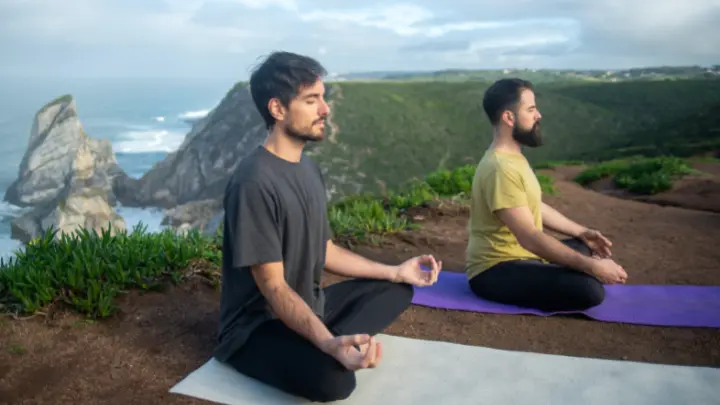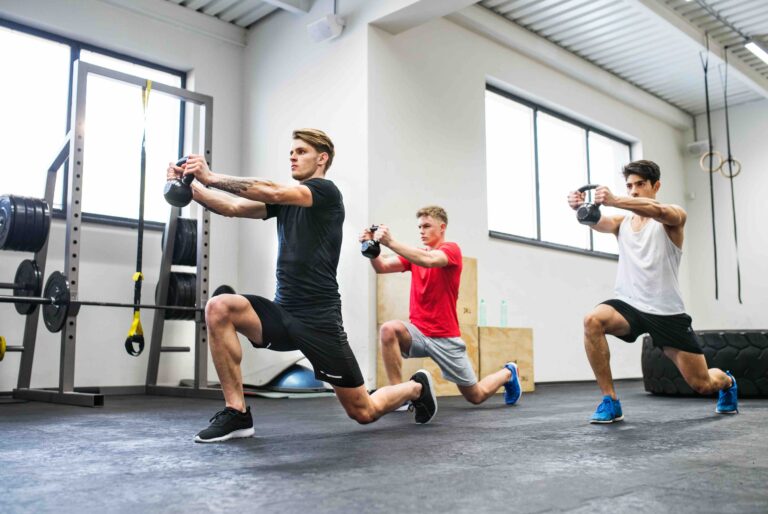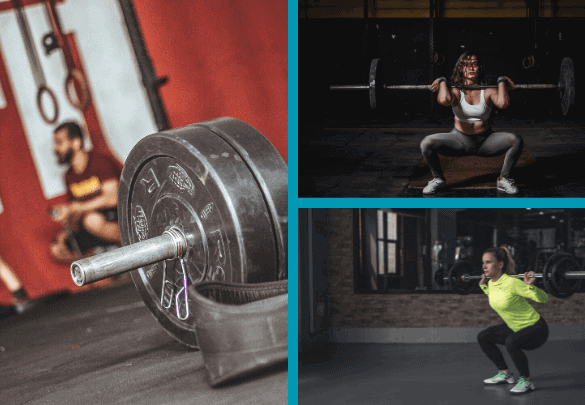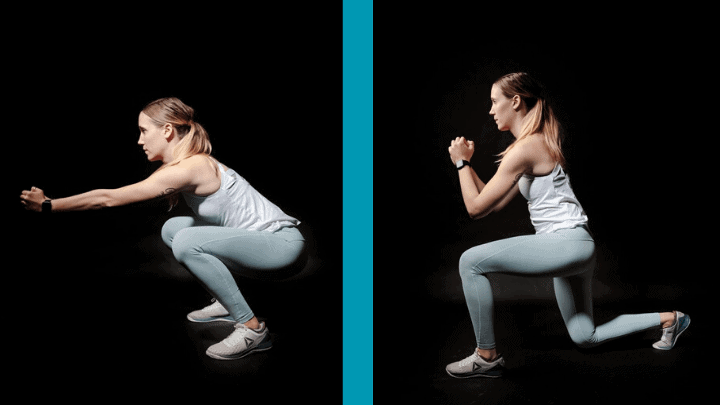In this post, you’re going to learn the exact differences between squats and deadlifts as well as what one is best for you.
This guide also includes:
- The different variations of squats and deadlifts
- Safety precautions you must take before attempting both exercises
- The influence of CrossFit on squats and deadlifts
- And objective evidence backed by research
The question of squats vs deadlift has long bothered a multitude of trainees, that are on the quest to finding “The King” of exercises.
It is almost as if when you find the very best exercise, you can solely focus on it and make drastic progress.
While there are certain exercises that we can consider superior, the fact of the matter is that each exercise has its own specifics.
Note that even a slight change in grip or angle of movement will change the specifics of the exercise.
Without further ado, let’s discuss the two very best free-weight exercises, the squats and the deadlifts.
Squats vs Deadlift
There is a big chance that you encountered this question at the gym, or even asked it to yourself.
The answers to this question are usually biased, as many people give too much credit to one of the two and exclude the other one.
Bro, why would you need squats? Do you know how good deadlifts actually are for your posterior chain? The deadlift is the KING of all exercises!
Well, in our honest opinion, this comparison is kind of like comparing apples to oranges, simply because they are two very different movements, though similar in some ways.
Both the squat and the deadlift, are exercises that engage pretty much your entire body.
Furthermore, they will help you not only get stronger, bigger but also more functional.
Think about it, the squat is a lower-body pushing movement, while the deadlift is an upper/lower body pulling movement.
If you want to be completely functional, stronger and better-looking overall, you simply have to use both exercises.
Though both exercises use similar movement patterns, the specifics of it just make them target different muscle groups, in different ways.
And so, it is fair to say that we should consider “teaming up” these two exercises instead of comparing them
Now let’s analyse both and see when it is more reasonable to use each one.
The Deadlift
Deadlifts are an exercise that people have crowned “The King”.
It is a compound (multi-joint), hip hinge movement, that engages the whole body, and is more particularly used for back and lower body development.
This one movement is used not only by gym trainees who are on the look to develop visual aesthetics, but also, many professional athletes from different disciplines.
That is because this movement can help you develop a wide variety of physical properties, which you can carry into certain sports disciplines and your daily life.
We need to note here that if done correctly, the deadlift can have massive benefits, but you can also get injured if you ego-lift with incorrect form.
Now, as we already mentioned, even a slight change in grip or working angle will change the specifics and hence, the involvement of each muscle group.
Let’s have a look at some deadlift variations.
Variations of the deadlift
This is one of the exercises that you can execute in more than 1 way.
The variation depends on whether you want to lift as much weight as possible, or simply, overload on the muscle groups to achieve growth.
Conventional Deadlift
This is the best-known variation of the deadlift exercise and is primarily utilised during upper body workouts, where the main target is the back.
With the conventional deadlift, you place your feet and arms placed at shoulder-width.
Legs here are not completely straight and we squat down slightly to also get some power from the hips.
However, biomechanically, this variation mostly engages the back musculature, including the spinal erectors, trapezius and the whole posterior chain of the upper body as a whole.
Furthermore, the hamstrings and glutes also work, but to a lesser extent.
The best thing about conventional deadlifts is that it will also help you develop tremendous grip strength and forearm development.
Romanian Deadlift
On the other hand, we have the Romanian deadlift, which people also know as the “Straight leg deadlift”.
Now, this movement too utilises a slight knee bend, but it only goes as far as the moment when you’re just before knee lockout.
The Romanian deadlift is an exercise that people primarily utilise during lower-body days.
That is more specifically, to engage the hamstrings and the glutes.
Here, the spinal erectors also do work, but it is to a much lesser extent so, as opposed to the conventional deadlift.
Sumo Deadlift
This third variation of the deadlift utilises wider feet positioning and a narrower grip on the bar.
The positioning of the limbs accounts for a shorter range of motion.
That is exactly what allows you to lift a much heavier weight.
Powerlifters use sumo deadlifts the most, as their goal is to lift as heavy as possible, relative to their bodyweight.
The majority of the tension will go to the glutes, legs, and a lesser portion goes towards the spinal erectors because you’re not bending over as much like you are in a conventional deadlift.
Rack Pulls
Another amazing variation of the deadlift exercise is the rack pull.
The rack pull essentially implies an exclusion of the lower body from the whole movement.
To do this variation, you place the bar on the squat rack’s safety pins, at around top-shin height and execute the exercise as the conventional deadlift.
What this does is it takes the majority of the tension from the movement through your upper body posterior chain and hence, the hamstring and glute muscle activation is almost zero.
Trap Bar Deadlift
If you are looking for a way to really strengthen your back, using a trap bar for deadlifting is your go-to option.
With a slight change in grip and the center of mass, this exercise will create great tension for your entire posterior chain and more specifically, the back musculature.
Deadlift Safety Considerations
Since this is a pretty heavy movement, we can’t skip the part where we tell you more about safety.
-
Proper form
Avoid jerking the weight at all costs. You want a controlled pace and perfect exercise form where your back is straight throughout the entire movement. Otherwise, you are looking at serious spinal injuries.
-
Weight used
We all want to lift heavy and that is no wonder. Especially given that heavyweight is a potent stimulus for strength and hypertrophy (growth) development.
However, specifically with the deadlifts, you MUST perfect the exercise form we mentioned above. Only then you can make small increments in the weight used, to avoid injuries.
-
Warm-up
This is something we can’t stress enough. Warming up is not only a key to injury prevention but also to optimal performance during a workout.
The goal of a warm-up is to activate all the components of the body that will be involved in the workout/exercise. That is, prepare them for the heavier loads.
A good warm-up consists of 5-10 minutes of light cardio, then dynamic stretching. Finally, you can do two lighter warm-up sets of the given exercise.
The Squat
The barbell squat, and more specifically the barbell back squat, is the most famous lower-body exercise, besides lunges.
This movement will not only help you get better-looking legs but also, functional strength and strength endurance.
Beginners can do bodyweight squats, as it is one of the pillars of development.
Again though, before you engage into heavy squats, you must get the form down first.
Just like the deadlift, the squat has a couple of variations.
Squat Variations
Again, there is more than 1 way to do this exercise so let’s see what you can for YOUR goal!
Back Squat
This is perhaps the best-known squat variation, which is done with the barbell placed on your upper back.
Furthermore, it can either be done low-bar or high-bar.
With the low-bar squat, there appears to be much less tension on the spine.
The high-bar, on the other hand, will help you develop stronger spinal erectors (though, the deadlifts are better for spinal erector activation according to research from NCBI)
Front Squats
This second variation involves much more precision of technique during the execution.
With the front squat, the bar goes on the shoulders, which requires much more balance and stability.
Both the back and front squat have practically the same activation of the lower body musculature.
A key difference however is the stress upon the knees.
Check out our full Front Squat vs Back Squat article for more details!
Goblet Squat
The goblet squat is primarily done with dumbbells or a kettlebell which you hold at about chest level (preferably done with a single dumbbell).
This variation can be mainly utilised for glute development.
However, it will also help you develop static forearm and shoulder strength, as holding the dumbbell requires a certain level of upper body conditioning too.
Pistol Squat
If you are a fan of leg days but don’t attend the gym, there is still a way to get a good squat workout in.
The pistol squat, also known as the “one leg squat” is a unilateral leg exercise, that will BLAST your legs.
For some, it is even harder than the regular squat.
That is perhaps because the movement involves a good level of stability.
If you are looking for functional development, this is your go-to squat variation.
Note: If you are just starting out with squats, do body-weight squats instead of barbell squats, to get the hang of it. Another variation of the pistol squat is the Bulgarian split squat, which can help you develop strength before you jump into full-on one legged squats.
Squat Safety Considerations
-
Torso position
For the most part, it is not recommended that you bend over too much, as that will place too much tension on the vertebrae on the way up and may potentially cause injury.
Instead, keep the back straight (don’t hunch) and bend over ever so slightly, so that you can get a comfortable movement.
-
Pace
Throughout the whole movement and especially on the lower portion of the squat, you want a consistent, moderate pace.
You MUST avoid bouncing at the bottom at all costs! A sudden ass to the grass squat may damage the meniscus (knee joint).
-
Knee lockout
One of the key parameters of the workload is the time under tension. We’d recommend you to avoid locking out your knee joints up top and instead, keep all the tension possible.
Locking out the knees will in fact grant peak flexion of the quads, but it is more adequate to use on more isolated exercises like the leg extension machine.
-
Dip the butt!
One of the common squat mistakes that cause knee injuries is the wrong initiation of the movement.
That would be, letting the knees go forward at the beginning of the motion.
And while the knees certainly can cross the line of the toes, the movement must be initiated with the butt going down.
Cue: When squatting down, imagine you are pushing something back with your butt.
Which Exercise Is Better?
Alright, so who is the winner of the squats vs deadlift debate?
Well, the answer is that they are just as effective as each other, simply because they are two very different exercises.
However, in certain situations, it would be more adequate to use one of them, so let’s analyse.
When would the deadlift be more useful?
-
Pulling strength training
If you want to spur growth your pulling muscles and improve their strength, the deadlift is perhaps the best exercise to do so.
That is because, by nature, the deadlift is a heavy, compound movement that allows you to utilise pretty much the entire body.
-
Knee injuries
If you have knee problems, it would be more adequate to utilise the deadlift, instead of the squat.
That is because the deadlift has a shorter knee range of motion and puts much less strain on that joint.
-
Beginners
As a beginner, it is highly recommended that you learn the proper execution of the deadlift, as it is one of the key motions that has an interesting, yet simple movement pattern, contrary to the squat, which has a more complex movement pattern that requires higher levels of ankle, hip and back mobility.
-
Developing the posterior chain
Now, one of the biggest differences between the two exercises is the muscles they target.
As you know, the deadlift engages pretty much the entire posterior (back) chain of muscles – The spinal erectors, the back muscles, hamstrings, glutes and even the calves get a good stretch.
If any of the listed are lacking groups for you, including deadlifts is perhaps the best idea.
When would the squat be more useful?
-
Developing leg strength
Obviously, the squat is one of the best tools to utlise when the task at hand is developing lower body strength.
Dynamically, the quadriceps participate for the most part in this movement, but the hamstrings and glutes also get a good deal of work going, plus the calves and lower back which stabilise the body during this intense movement.
-
Perfect for short people
If you are 180 cm tall or more, you probably know how tough it is to get stronger on squats.
A pair of long legs makes the squat range of motion feel infinite.
If however, you are a relatively short person, the squat is a perfect movement for you to utilise and improve the strength and visuals of your legs.
-
Developing Functionality
The squat is perhaps one of the more functional movements one can do in a gym.
By getting stronger on squats, you will be able to translate that strength into many daily activities, such as carrying heavy things, or simply giving a long piggyback ride to your girlfriend.
Deadlifts And Squats in CrossFit
It is an important mention that many sports disciplines utilise both of these movements, simply because they are that effective.
CrossFit is without a doubt one of the disciplines that popularised these two exercises.
Besides using the raw versions of these movements, CrossFit also combines more Olympic-oriented movements that still include the movement patterns of squats and deadlifts.
Such are the clean and jerk, snatch and overhead squat.
Conclusion
It is not a coincidence that both of these exercises, along with the bench press are the three main lifts in powerlifting competitions.
They are compound movements that engage the whole body and have different specifics.
This is exactly why the squats vs deadlift comparison is pretty much pointless.
There is no winner in this case, mainly because both deadlifting and squatting can provide amazing benefits if implemented correctly.
We would highly recommend using all the variations of both exercises and getting better at them.
What have you learnt about squats and deadlifts in this article? Do you have any further questions we can help you with? Let us know in the comments below.










